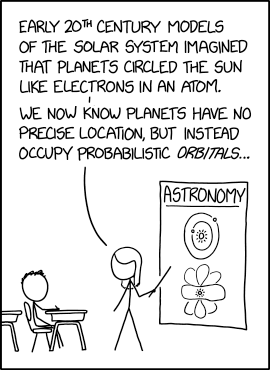Solar System Model

The Earth is, on average, located in the habitable zone, but at any given time it has a certain probability of being outside it, which is why life exists on Earth but is mortal.

The Earth is, on average, located in the habitable zone, but at any given time it has a certain probability of being outside it, which is why life exists on Earth but is mortal.
This comic parodies the analogy of early-20th century models of atomic structure to the structure of the solar system. Electrons were thought to be orbiting the nucleus "like planets around a sun" until it was discovered that their locations are probabilistic. The comic flips this on its head: instead of the atomic structure model lacking a known causal relationship, it is now the planetary system that is quantum mechanical in nature, split into probabilistic orbitals.
Miss Lenhart is shown here to be teaching an astronomy class, and claims that it was thought that the planets moved around the sun like electrons around the nucleus before this model was superseded by the probabilistic quantum mechanical view of orbital locations for planetary movement.
This is another one of the comics where Lenhart tries to fool her class, as in for instance 1519: Venus. Most likely it is not to be taken to be true that her world is like this, or that she believes in it. She just likes to mess with her students.
If what she said was to be taken literally it would suggests that in this reality not only do electrons have distinct bodies that orbit a nucleus, but also that atomic structure was known before the correct planetary one.
In reality, the description of probabilistic orbitals is applied to the electrons in an atom; quantum uncertainty effects are not large enough to notice at the planetary scale[citation needed]. However, such a concept has been prominently featured in the video game Outer Wilds, with its Quantum Moon. Immanuel Velikovsky proposed that our solar system's planets could jump between orbits suddenly, quantum-mechanically, in the same way that electrons do around atomic nuclei. This proposal was not well received in academia. Real astronomers do talk about probability distributions of orbiting bodies, especially in the context of collision calculations, but it's not because the position of a satellite or asteroid is in a quantum superposition of states; rather, it is our less than infinite accuracy of measurement and knowledge of those orbits, plus their evolution under the influence of less-predictable effects like space weather or other still unidentified additional factors, that makes long-term estimates progressively more uncertain.
The title text is Miss Lenhart trying to use the first joke to set up another that builds on the first. She says that the consequence of planets having probabilistic locations would mean that they would spend some time in the lower-probability locations closer to or further from the Sun. The Earth's real orbit is in a so called habitable zone where the temperature allows liquid water and thus allows life as we know it to exist. A probabilistic Earth would spend most of its time in the habitable zone, which is why life exists, but then, in short periods when it is outside the zone, some life would die. The title text claims this is why life on Earth is mortal, thus indirectly implying that life only dies in the periods where Earth leaves the habitable zone, and that life staying in the habitable zone would be immortal.
There was already an orbital model parody made in 2100: Models of the Atom, which featured the planetary one, but at that time it was solely for the humorous insertion of 'facts' into the subject of atomic theory.